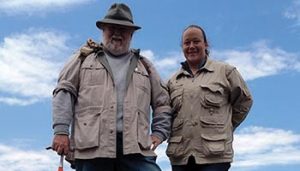
By Joseph “PaleoJoe” Kchodl
The site where this Ordovician trilobite was found is now closed to the public, so it has become very rare to find an example of a CRYPTOLITHUS bellulus.
It is a unique trilobite with a very broad cephalon with very bulbous glabella and numerous “pits” or holes in the brim. It is believed that it was a filter feeder funneling water through the pits and filtering its food through there.
They have been found in the Martinsburg Formation of Swarta Gap in Pennsylvania. Typically they are only one inch long and end in a very small tail spine.
Trilobites, an extinct form of arthropod related to insects, crabs, crayfish, and horseshoe crabs, are among the most prevalent invertebrates with hard body parts to appear during the Cambrian Period. These creatures are called trilobite due to the three distinct “lobes” running vertically through the body section.

About the columnist: Joseph “PaleoJoe” Kchodl is a paleontologist, educator, veteran, author, fossil dig organizer/guide, business owner, husband, father, and grandfather, and fossil fanatic. For decades, he’s spent hours in classrooms around the Midwestern United States and beyond, speaking to school children about fossils and fossil hunting. Visit his site to purchase fossils, contact PaleoJoe, visit www.paleojoe.com.
Plus, learn more about PaleoJoe and his daughter PaleoJen and their paleontology exploration partnership in an the article “Fueling a Passion for Paleontology“.
If you enjoyed what you’ve read here we invite you to consider signing up for the FREE Rock & Gem weekly newsletter. Learn more>>>
In addition, we invite you to consider subscribing to Rock & Gem magazine. The cost for a one-year U.S. subscription (12 issues) is $29.95. Learn more >>>


 Hide i
Hide i












